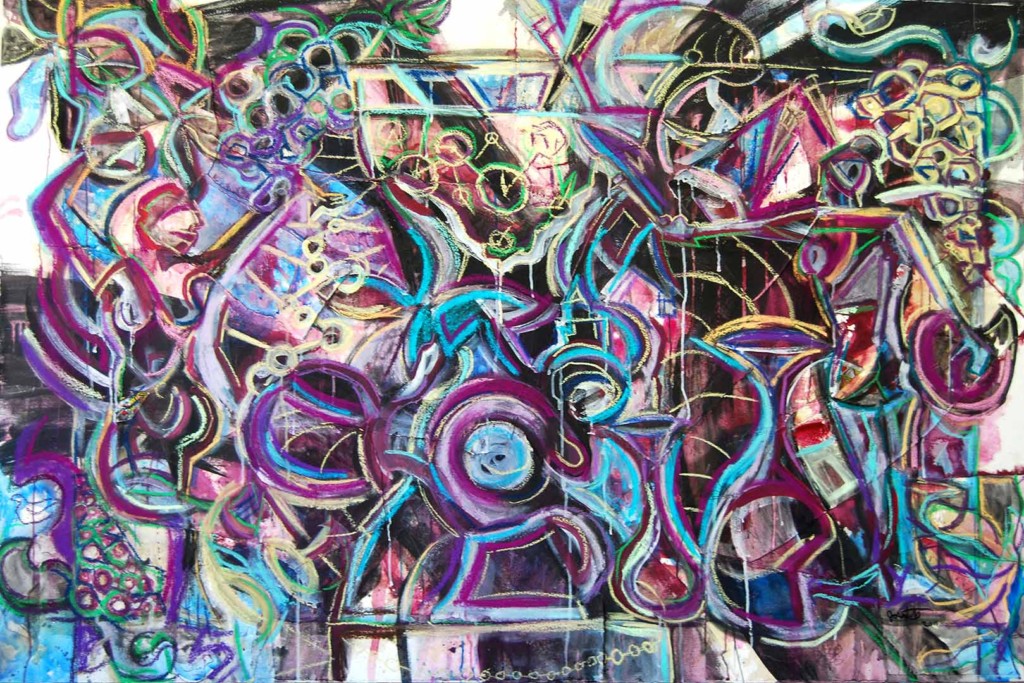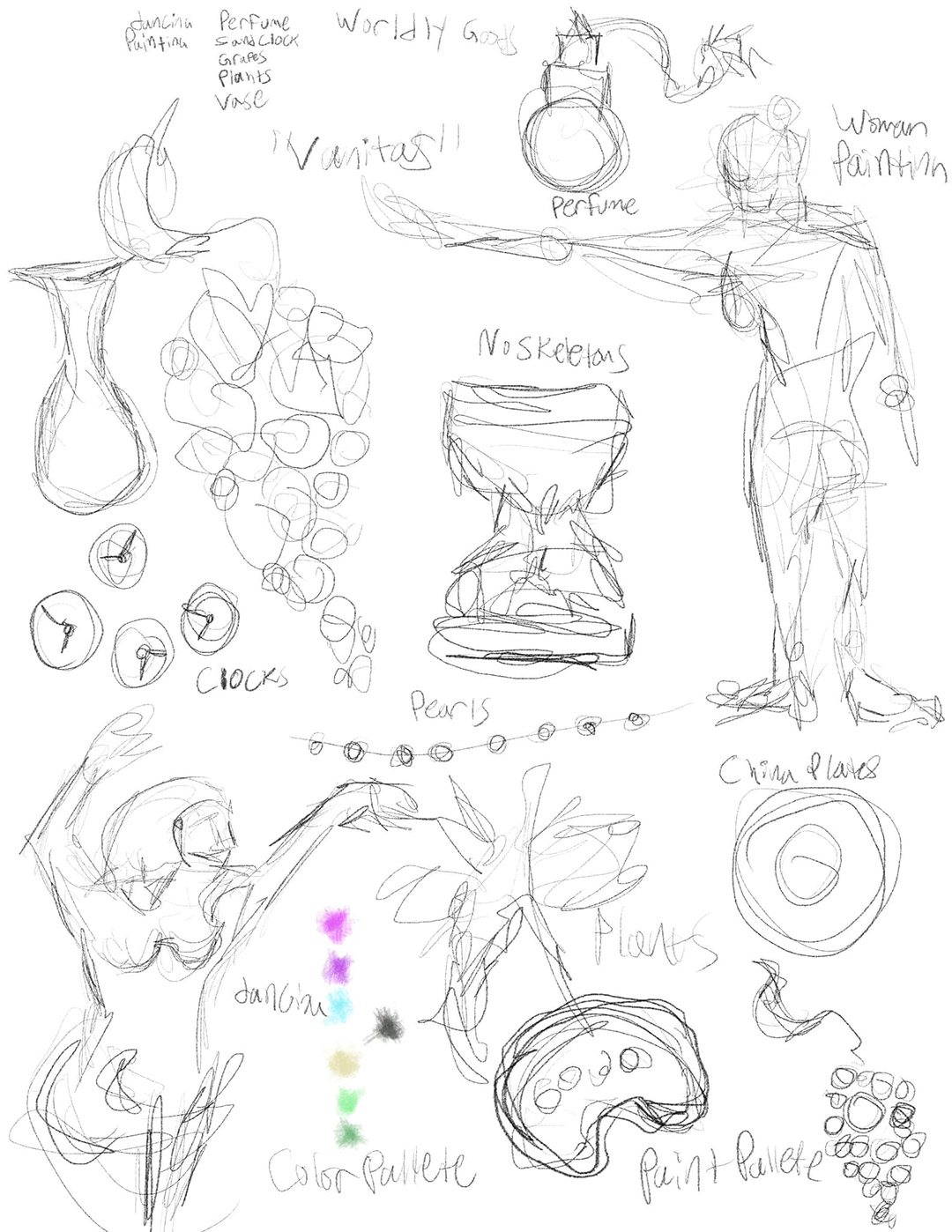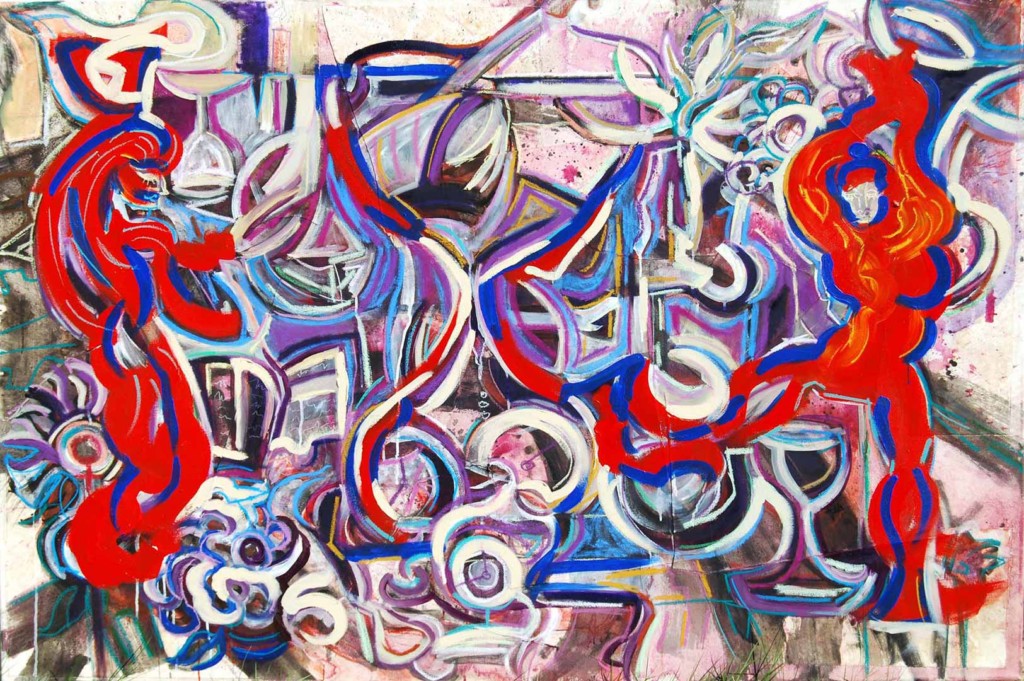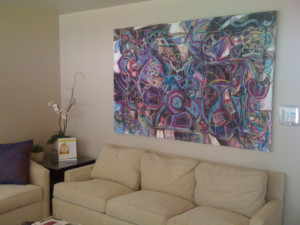How I combined influences from Flemish Rennaissance art and modern abstraction for an art commission for a medical office waiting room
I was commissioned to create a painting for the American Institute of Plastic Surgery in Plano, Texas. This would not be the last sale or commission I would engage in with this organization. In fact, in one way or another they have been one of my most significant collectors so far.
I was challenged by a designer to come up with a concept that would work in conjunction with their concept
By this point I was working as an in-house artist in residence for a few years. I had my first solo exhibition under my belt as well.
Sherry Hayslip Interiors approached me with an idea to create an interpretation of a vanitas painting in my creative style. A few general objects and ideas were given as a guide. I was specifically asked to avoid inclusion of the skull that is typically included in a vanitas still life, for what would probably be obvious reasons. Mostly not to frighten the visitors, especially since this was to be created for a private waiting room.
Getting inspiration from Franz Kline for the ground of the painting
Franz Kline had a big impression on my art when I was studying 20th century art history. I really liked the idea of including broad sweeping high contrast gestural markings in these paintings. I had already flirted with this somewhat with my 2nd commission ‘Balance‘ and I wanted to continue that thread into this painting. I did make a somewhat conscious decision to not make the marks completely dark as I knew this would allow for a somewhat more nuanced depth of field.

“Vanitas #1”
60 in. X 72 in.
Mixed media collage on canvas
Sold
Incorporating gestural representations of the human figure as a way to express movement, ambitions, talents, and characteristics
in the center right and left portions of these paintings you can see abstract gestural renditions of human female figures. They can be seen acting out in different activities such as painting, writing, dancing and more. My idea was to express this along with the worldly possessions such as wine grapes, jewelry, pottery, and other assorted personal items. The intent being is to show that people are more than the sum of their personal possessions. They have aspirations to grow and be more whole individuals. This adds a more modern layer of dimension to this type of creative exercise in concept. Not to say that there were not rich stories behind the original high renaissance still lives, but the context of people’s lives and aspirational goals has evolved in many ways, especially for women.
Recreating the sketched ideas
In 2024. I decided to recreate a set of sketches for my 2011 commission ‘Vanitas #1’ and ‘Vanitas #2’. While the rough sketches reflect what would end up going into the panting, I think this kind of shows how much is going on in the paintings once you separate the ideas into individual drawings. I’ve got a whole article on my website exploring this project on my website, and I did this to further illustrate the thought process behind these pieces. They were created for a medical office in Plano. I was given some prompts to work with to develop my ideas. and I ended up taking cues from later northern Renaissance art. While my work is generally very modern, there’s always a rich bit of ideas you can get when you look back at history. Overall, I chose a set of images or objects that might signify worldly feminine goods or items, as this related to the practice and concept around the space.

Some historical background on the Northern Renaissance
The Northern Renaissance was a period of artistic and cultural flourishing in Northern Europe from the late 14th to the early 17th century. During this time, artists began to create still life paintings that featured vanitas imagery, which was meant to remind viewers of the transience of life and the inevitability of death. Vanitas still life paintings were popular in the 16th and 17th centuries and featured objects such as skulls, hourglasses, and extinguished candles.
the significance of a still life in this period of art history. Also skulls.
One of the most striking and memorable elements of Northern Renaissance vanitas still life paintings is the use of skeletons. These skeletal figures were often depicted alongside other objects, such as books or musical instruments, to emphasize the contrast between the beauty and fragility of human life and the inevitability of death. The skeletons were a powerful visual reminder that life is fleeting, and that everything we value in the world will one day be reduced to dust.
Hans Holbein
One of the most famous examples of a Northern Renaissance vanitas still life featuring a skeleton is “The Ambassadors” by Hans Holbein the Younger. This painting, which was created in 1533, features a skull that is painted in anamorphic perspective, meaning that it appears distorted when viewed from certain angles. This distortion is meant to remind viewers that the skull represents the inevitability of death, which is an ever-present reality that is often hidden from view.
Art as a reminder to reflect on oneself on morals and mortality.
The significance of the imagery in vanitas paintings goes beyond just reminding viewers of the transience of life. These paintings were also intended to be moralistic, encouraging viewers to reflect on their own lives and consider how they could live more virtuously. By including objects like books and musical instruments, vanitas painters were suggesting that intellectual and artistic pursuits were valuable in and of themselves, but that they should not distract us from the reality of death.

These paintings were not meant as any sort of morality allegory, and the idea of mortality was only partially intended.
As this commission was directly by the wonderful people at Sherry Hayslip Interiors, I got some great ideas to explore. I definitely love the idea of modernizing the idea of a vanitas ‘still life’ into something new and unique. I was definitely asked to not include a skull in the painting for obvious reasons, and that would’ve changed the tone of this painting in a direction I am not particularly on board with.
I only say that including a metaphor for mortality is in the painting is partially a joke. More than anything the idea is to change the meaning of these paintings to be something that celebrates life, and not in any morbid way.
Creating another set of paintings for this space under different direction
As stated previously, I would go on to create more art for this client. I was asked by the client to meet with them to discuss another painting for their office. This resulted in the painting ‘Under the Angel Oak‘ and later the painting ‘Nebula.’ The process of creating these new pieces came under the directive of the client to create something ‘more soothing.’
This proved to be a very fruitful challenge. The influence on these paintings was more from the fluidity of Matisse than the geometry of Picasso. This style would also lead to more paintings like ‘Winter Rythm.’ I would prefer to keep this section brief and focus on these types of painterly abstracts at a later time.
The second painting in this series sold to another one of my major collectors
This painting was later sold to another client and is in the same collection as this painting and this painting. The client and the designers chose the orientation for this piece that best suited their vision and needs. This client has been a major collector of mine.




